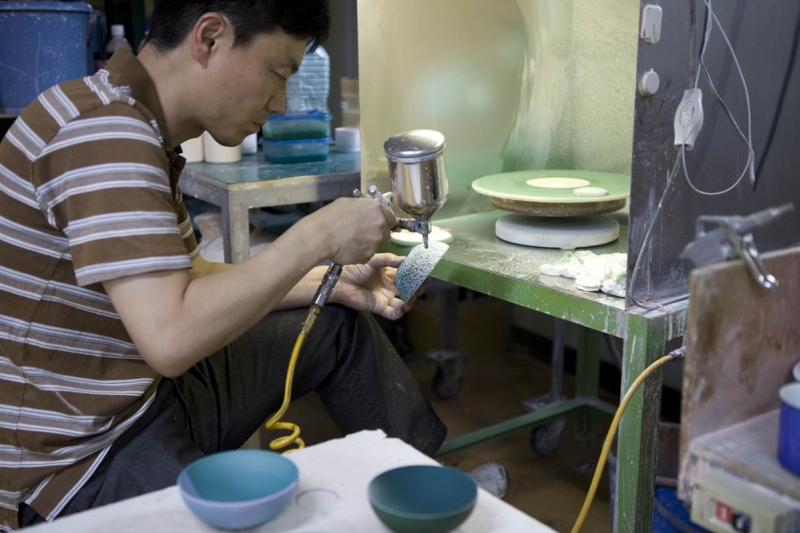Interview: Mr. Noriyuki Momota, Momota Touen
Mr. Noriyuki Momota is the president of Momota Touen Corporation, a pottery trading company in Arita and a key figure in the story of the 2016/ project. Momota Touen has been an established feature in Arita for centuries, it is a family business and Mr Momota is the sixteenth president to steer the company. In 2012, Mr Momota set in motion the precedent for the current 2016/ project; he launched a new brand called 1616 / arita japan together with designer Yanagihara Teruhiro and Dutch design studio Scholten & Baijings. The 1616 / arita japan brand was successful in its ambition of reminding the international market of Arita’s excellence in porcelain production and in reinvigorating the industry at home. Mr. Momota tells us about the problems that Arita is currently facing and the role of his trading company in the solution.
- Can you explain to us the evolution from 1616 / arita japan to the new 2016/ project?
1616 / arita japan is a project that involves only three potteries and one trading company, Momota Touen, in Arita in the making and selling of new porcelain. We want the industry in the area to grow substantially and to do that all the trading companies and potteries in Arita need to work together. If we don’t progress as an industry and a community, learning from the successful 1616 / arita japan project and expanding on it, then 1616 / arita japan will end up as a one hit wonder. Therefore, with this new project we spread the collaboration with international designers to other potteries and other trading companies in the same area and are attempting to create a new collection of porcelain produced by the entire town of Arita to show to the world. This is how the idea of 2016/ was born.
- Has it been easy for craftsmen at the potteries to work together with the international designers?
It has been difficult on several occasions. The craftsmen have been making Aritaware for many years, they have pride in what they do and they have a preconception of how Aritaware should be. So, when looking at the designs of Yanagihara and Scholten & Baijings, they question the new approach. They say; "We don’t call it Aritaware if it does not have glazing" or, “A bowl without a traditional foot is not Aritaware." When prototyping, the makers sometimes adapt or interpret the new designs to become something more familiar to them. But, because we have been obsessed with the old ways of making we have been left behind in the dust, this is part of the problem facing Arita. So I ask the craftsmen to make prototypes as true to the design proposal as possible. If you change the design, there is no sense of working together with designers. These craftsmen have great skills, I ask them to complement the design by making the best use of their skills.
- What is the role of a trading company such as Momota Touen in promoting Aritaware in Japan and in the world market?
We stand between the designers and potteries. In the case of the 2016/ project we work closely with the two creative directors to select the items to be manufactured from the designers proposals and we then distribute the resulting Aritaware to the right retailers. The reason 17th century Japanese porcelain was in the hands of so many wealthy foreign customers was because of the important role that the Dutch East India Company played as a trading company. The East India Company commisioned the potteries of Arita to produce vast amounts of tableware and vases for Europe. Then, there were only potteries in Arita and the trading companies were found in the neighbouring city of Imari where the porcelain was shipped through the Imari Port to the domestic market. Today, trading companies are needed to select the products that consumers are looking for and to deliver the products to dealers. Gradually the number of trading companies has increased in Arita.
- Was Momota Touen always a trading company? How has Momota Touen survived for such a long time?
Momota Touen was a manufacturer first of all. After the Second World War, the company was transformed into a trading company. So therefore we understand not only the logic of selling Aritaware but also of the craftsmen and their ways of making. During the 1980s there was a buoyant economy in Japan and a great number of orders came into Arita and Imari from ryokans; luxury inns. However, when the economic bubble burst, many makers of luxury porcelain went out of business. Still, the potteries of Arita were able to somehow survive. This is largely because of the tradition of making porcelain in Arita is such that the processes; making clay from porcelain stone, moulding, firing, glazing and trading, are divided up and companies specialise in each aspect. Those individual companies are connected together as business partners and it has made the industry stronger, more robust to change.










